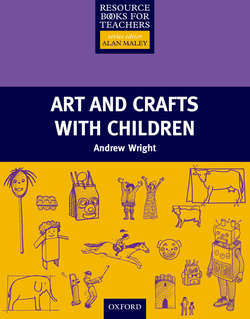Читать книгу Arts and Crafts with Children - Andrew Wright - Страница 6
Introduction
ОглавлениеLanguage learning and art, crafts, and design
Children learn by doing. When they are involved in art, crafts, and design activities, language can play a key part. Although much of what is done in art, crafts, and design is non-verbal, for this book I have chosen activities in which language plays a central role.
The important role of language in art, crafts, and design is evident when children are:
– listening to, and perhaps reading instructions on how to do something. They are associating the new language directly with objects, actions, and experiences, rather than merely with existing experience through translation of the mother tongue.
– making use of their existing language skills (which they employ when reading in their mother tongue), for example, when guessing meaning from context
– receiving and giving praise and encouragement
– describing, evaluating, and expressing feelings and ideas.
This range of purposes and associated language is not found in traditional foreign language teaching at primary level, in which songs, rhymes, and games are the sole diet. However good this traditional ‘food’ of songs and games is, it cannot provide the balanced diet essential for a child’s broad conceptual development.
The value of art, crafts, and design at the lower proficiency levels
Art, crafts, and design are particularly important at the lower levels because they make a child’s limited range of language part of something bigger – something which is strong, rich, and has material presence. For example, the word ‘me’ on its own is worth little or nothing, but written below a self-portrait of a child it becomes meaningful, and is much more likely to be remembered.
The educational value of art, crafts, and design
When working with children, we are first of all teachers who are responsible for the overall development of those in our care. Our role is to introduce activities, materials, and values which deepen their awareness and understanding of the world around them, and their relationship with it.
In my opinion, it is not enough for me merely to help the children to name a colour in English. I should also help them to become aware of the wonderful varieties of colour which we can perceive and make, and to deepen their associations with colour.
Art, crafts, and design activities can help children to:
– appreciate the world around them
– be more aware of the five senses, and develop skill in using them
– develop skill in comparing, contrasting, classifying, sequencing, and organizing
– acquire awareness of artistic form (shape, colour, line, texture, length, weight, movement, etc.) and materials, and skill in handling them. They will also become aware of the concepts represented, and their value. (Consider the value of fresh personal vision based on direct and honest response to experience, as opposed to the commonplace, the stereotype, and the cliché. As an example, think of the immense range of colours found in the bark of a tree, and contrast this with the ‘pass-me-down’ colour brown routinely used by children in a million pictures.)
– understand ‘cause and effect’, and develop a skill in discovering them
– develop a skill in problem-solving
– have a positive attitude to exploring, and to making sense of experience
– have a positive attitude to themselves, and to others, and to working with others.
Art is not just a hobby, it is a fundamental aspect of human behaviour which involves intellectual as well as emotional exploration, expression, and communication.
Who is this book for?
1 Children
This book is for use with children aged between four and twelve, and includes activities for the whole of this age range.
Clearly, there is a big difference between four– and twelve-year-olds! Very young children:
– are in the early stages of awareness of texts, whereas older children are usually fluent readers
– tend to respond to individual happenings rather than considering general principles
– are less likely to be interested in adult subject matter and perceptions than older children
– are more likely to need constant adult guidance
– are less able to sustain concentration and a sense of direction than older children
– have less manual dexterity.
Each child (like each adult) is an individual, with their own natural speed and focus of development. Some children of four can use a pair of scissors with great dexterity, for instance, while others can’t. I have tended to place the age at which an activity can be done as the age when children are likely to get some satisfaction out of doing the activity, rather than the age at which they can do it easily.
Most of the activities can be adapted for use with children of different ages and at different stages of personal development.
Proficiency level
Most of the activities in this book are possible for beginners and/or elementary learners of English. Children who are more proficient in English will enjoy doing the activities at a richer linguistic level.
I firmly believe that, from the very earliest days of learning a second or foreign language, children should experience the new language through activities which are meaningful and important to them.
2 Teachers
This book is for teachers who believe that it is vital for the children to experience the new language as an important tool to be used in meaningful and enjoyable activities.
